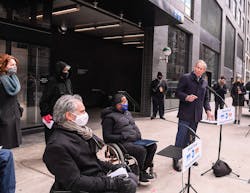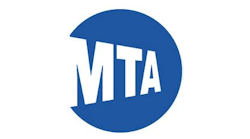MTA looks to zoning policy proposal to expand system accessibility
Metropolitan Transportation Authority (MTA) recognizes it has accessibility challenges. While 50 percent of Metro-North Railroad stations are accessible, only 24 percent (five out of 21) Staten Island rail stations are accessible and 28 percent of New York City’s 472 subway stations are accessible.
“As we are painfully aware, our public transit system is not equally accessible to all New Yorkers, especially people with mobility disabilities who are effectively denied access to over two-thirds of our subway system,” said Council Member Farah N. Louis, Chair of the New York City Council Committee on Mental Health, Disabilities, and Addiction.
However, a proposed change in zoning policy aims to incentivize developers to work with MTA to deliver improved accessibility to a wider swath of the region’s transit network. MTA calls the proposal Elevate Transit: Zoning for Accessibility and says it would allow the authority to “leverage planned private development to achieve a fully accessible transit system faster while saving taxpayer dollars as the MTA faces financial challenges caused by the ongoing pandemic.”
"COVID has revealed once again the stunning disparities in our city and one of the gaps that we don't talk about as much is our accessibility gap. Hundreds of thousands of New Yorker's can't navigate our public transit system because of limited mobility. We have to do more and this proposal is an important step,” said Rafael Salamanca, Council Member and Chair of the Land Use Committee.
What is being proposed
MTA says all parts of the city will benefit from the proposal as it would allow more stations to be made accessible within a faster timeline and help leverage the $5.2 billion included for accessibility improvements in the authority’s restarted 2020-2024 Capital Plan.
MTA Board Member and Commissioner of the New York City Mayor's Office for People with Disabilities Victor Calise explained the proposal was developed with input from disability, transit, and senior advocates as well as the urban planning and real estate communities.
"Zoning for Accessibility will be a game-changer that will enable the MTA to go beyond the existing accessibility commitments in the 2020-2024 Capital Plan and add elevators throughout the transit system at an even faster pace—all while saving money in the process," said Calise.
The Elevate Transit: Zoning for Accessibility proposal call for developers to work with MTA on easement certification and expand the transit improvement bonus central business districts already offer.
According to MTA, the easement certification provision would require developers of sites adjacent to subway, Staten Island Railway, Long Island Rail Road and Metro-North Railroad stations within New York City to consult with the MTA first to determine whether the MTA needs an permanent access to a small piece of property, aka, an easement, for future accessibility projects at the adjacent station. If the MTA determines an easement is necessary, the developer will receive targeted zoning relief to compensate for the space needed for the easement.
The transit improvement bonus provision would incentivize private developers to directly fund and build new transit station access improvements, such as elevators or circulation improvements at already accessible stations. Developers in the highest density districts may qualify for a density bonus of up to 20 percent to help offset the cost of construction. Accessibility improvements attained through the bonus mechanism are achieved at no cost to the MTA and will be in addition to projects funded through the MTA’s Capital Plan. Each bonus application will still require a public review and approval process.
MTA’s current capital plan includes the goal of “maximum possible system-wide accessibility by 2034” with a benchmark of making 50 percent of stations accessibly by 2029.
“Zoning for Accessibility builds on the MTA’s historic $5.2 billion commitment to accessibility projects by partnering with private developers to help make more stations ADA accessible -- and to deliver them faster and cheaper than ever before,” said MTA Construction & Development President Janno Lieber. “Today, the MTA is looking to deploy new innovative approaches to attack big challenges, like making our entire mass transit system fully accessible.”
MTA Chief Accessibility Officer Quemuel Arroyo noted the partnership MTA has with the New York City Department of City Planning and the NYC Mayor’s Office for People with Disabilities in development of the proposal and said it would accelerate MTA’s systemwide access goals.
“This joint effort with the city and private sector will drive the type of innovation we need to create a more equitable city where all New Yorkers, and visitors, have access to everything the city has to offer,” said Arroyo.
Zoning for Accessibility will begin a formal public review process, including review by community boards and borough presidents, after referral by the City Planning Commission at its April 5 meeting.
For more information, visit: https://new.mta.info/elevatetransit.

Mischa Wanek-Libman | Group Editorial Director
Mischa Wanek-Libman is director of communications with Transdev North America. She has more than 20 years of experience working in the transportation industry covering construction projects, engineering challenges, transit and rail operations and best practices.
Wanek-Libman has held top editorial positions at freight rail and public transportation business-to-business publications including as editor-in-chief and editorial director of Mass Transit from 2018-2024. She has been recognized for editorial excellence through her individual work, as well as for collaborative content.
She is an active member of the American Public Transportation Association's Marketing and Communications Committee and served 14 years as a Board Observer on the National Railroad Construction and Maintenance Association (NRC) Board of Directors.
She is a graduate of Drake University in Des Moines, Iowa, where she earned a Bachelor of Arts degree in Journalism and Mass Communication.




